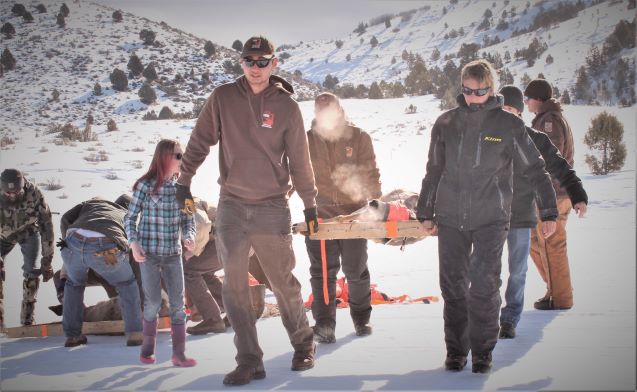HARDWARE RANCH – Division of Wildlife Resources and volunteers gathered at Hardware Ranch Wednesday morning to capture and evaluate deer does in the Cache District to see how area herds have done over the winter.

“We have placed GPS collars on does across the state,” said Mark Hadley, northern region outreach manager for Division of Wildlife Resources. “Those collars allow us to track the animals at the start of winter and again at the end of winter.”
WDR works with a capture company that uses a helicopter and a net gun to capture collared does this time of year.
“We will health check them to see if the winter was hard on them,” he said. “That information will tell us how the rest of the area’s herd wintered.”
The team was on the ground early in the morning and checked the deer’s health by weighing the does, taking blood and installing an implant. The implant will come loose when the fawns are born in June. Biologists will track the fawns and will collar them for future research.

A helicopter crew captured the does and flew them to a spot near the checking station. DWR and volunteers took the shackled and blindfolded deer on a gurney to a station to be evaluated. After they checked the animals out, they were unshackled, blindfolds removed and released.
David Smedley, a DWR biologist, oversaw the operation. Although he is relatively new to this area, he did similar work in the Gunnison area before coming to Cache Valley.
“We did two days of captures in five locations total. Besides Hardware Ranch, we did some near Laketown, Woodruff, one in the Richmond area and the final one was the Millville Wildlife Management Area at the mouth of Blacksmith Fork Canyon,” Smedley said. “We captured 40 pregnant does; some of them were already collared and some weren’t.”

All of the does were implanted with a fawn tracking device and a collar before they were released.
“We looked at the overall health and took measurements of all the deer we caught,” he said. “All things considered, the deer had a better winter this year than they did last year.”
A state veterinarian, Annette Roug, was also on-hand as she is with most of the captures in the state. She ensures all of the animals are in good health and uninjured before turning them back into the wild.

“Our sample of the deer in the Cache and Rich areas is a model for similar regions in the state,” Smedley said. “All in all, we have five areas in the state we monitor.”
Cache Valley deer are an example of deer survival in similar areas, DWR can use them as a model for similar areas.
“It went quick, no issues as far as the deer were concerned and we should have some good information from this year’s exercise,” Smedley said. “I want to thank all of the volunteers who came up and helped.”

